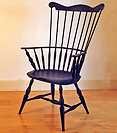(click on any of the thumbnails for a larger view)
 Windsor chairs originated in England in the late 17th century, probably from around High Wycombe rather than the town whose name they bear. The Thames valley in South East England was rich in Beechwood forests and it was here that the chair Bodgers set up their camps, harvesting the wood and turning the legs, stretchers and armposts on rudimetary spring pole lathes operated in the open air. These parts were then sent to the manufacturer to be mated with the seats, made by the Bottomer, and the bent arms and spindles made by the Framer, who also completed the assembly of the chair. The whole process was governed by the Guild system as were all the trades and crafts and it had been that way for centuries. Windsor chairs originated in England in the late 17th century, probably from around High Wycombe rather than the town whose name they bear. The Thames valley in South East England was rich in Beechwood forests and it was here that the chair Bodgers set up their camps, harvesting the wood and turning the legs, stretchers and armposts on rudimetary spring pole lathes operated in the open air. These parts were then sent to the manufacturer to be mated with the seats, made by the Bottomer, and the bent arms and spindles made by the Framer, who also completed the assembly of the chair. The whole process was governed by the Guild system as were all the trades and crafts and it had been that way for centuries.
The great innovation of the Windsor style was to divide the chair at the seat. Prior to the Windsor, the legs and back supports of virtually all chairs were made from the same piece of wood. By anchoring the legs into the seat and making the back a separate piece, it became possible to introduce more radical angles without sacrificing strength, resulting in a more stable and comfortable chair.
With the migration of Chairmakers to New England and Upper Canada, a further development occurred, because in the New World the Craftsman was free to make his own innovations as he was no longer bound by the restrictive Guild system. Many Chairmakers set up shop on their own and introduced new ideas and improvements as they occurred to them. Thanks to this translation of the style at the hands of the New World Chairmakers, we have the distinctive, graceful and comfortable chairs that are still popular today, over three hundred years later.
My love of these chairs has led me to study the methods by which they were made by the early Chairmakers, and to adopt the tools and techniques which gave the chairs their distinctive qualities. Thus, for me, making a chair begins in the forests around my Eastern Ontario home. I select the right woods for the particular parts of the chair. Straight grown Red Oak for the backs and spindles, hard Maple for the legs and stretchers and Pine for the seats.
The natural shrinkage of partially seasoned wood is used to obtain permanent joints. This means that tenons are fully dried in hot sand, while sockets are left semi-dry. A snug fit at the time of assembly shrinks to become very tight and hence immune to the seasonal changes of humidity that sooner or later loosen the joints of a conventionally made chair. By these methods and others, such as tapered seat and armpost tenons, wedged through joints, and assembly under tension, a chair of great strength is made.Seats are deeply sculpted for comfort, from boards of generous thickness, using Adze, Inshave, Drawknife and Spokeshave. Spindles are riven from logs then whittled, rather than lathe turned, to achieve greater delicacy of line with no loss of strength. In assembly, the slope of the back, height of the armrests and seat can be tailored to the individual for whom the chair is being made.
Traditionally, Windsor chairs were finished with Milk Paint in rich yet subtle tones. The painted surface draws the eye to the sculpted lines, and unifies the appearance of a chair made from several different woods. A final coat of linseed oil, later followed by paste wax, gives a lovely patina that only improves with age.
There were many variations of the Windsor chair. I have chosen designs I consider classics of the form and emphasize sculpture, strength and comfort. |